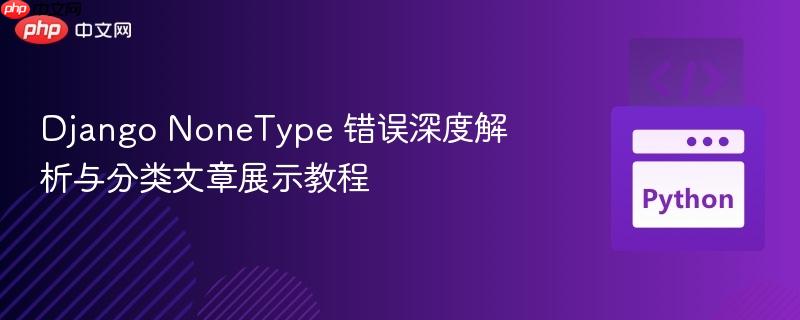
本教程深入探讨 django 中 `attributeerror: 'nonetype' object has no attribute 'views'` 错误的成因,特别是在 url 路由配置不当和数据查询为空时。文章将提供详细的视图逻辑修正、url 模式优化以及模板渲染的最佳实践,确保分类文章能正确显示,并避免因对象不存在而引发的运行时错误。
在 Django 开发中,AttributeError: 'NoneType' object has no attribute '...' 是一个非常常见的错误,它通常意味着你正在尝试访问一个 None 对象的属性。当数据库查询没有返回任何结果,或者在其他逻辑中变量被赋值为 None 时,就可能发生这种情况。本教程将以一个实际案例为例,详细讲解如何诊断、理解并解决这类问题,特别是在处理 URL 路由和分类文章展示功能时。
在提供的代码中,错误信息 AttributeError at /blog/cat1 'NoneType' object has no attribute 'views' 明确指出,在尝试访问一个 None 对象的 views 属性时发生了错误。结合堆栈信息,这通常发生在 blogPost 视图中:
# views.py
def blogPost(request, slug):
post = Post.objects.filter(slug=slug).first() # 关键行
post.views = post.views+1 # 错误发生在这里
post.save()
# ...这里的关键在于 Post.objects.filter(slug=slug).first()。当数据库中不存在与给定 slug 匹配的 Post 对象时,first() 方法会返回 None。紧接着,下一行代码 post.views = post.views + 1 就会尝试访问 None 对象的 views 属性,从而引发 AttributeError: 'NoneType' object has no attribute 'views'。
导致上述错误的一个重要原因是 URL 路由配置不当,使得用户意图访问分类文章的请求被错误地匹配到了文章详情页视图。
观察 urls.py 文件:
# urls.py
from django.urls import path
from . import views
urlpatterns = [
path('postComment', views.postComment, name='postComment'),
path('', views.blogHome, name='blogHome'),
path('<str:slug>', views.blogPost, name='blogPost'), # 文章详情页
path('category/<category>/', views.blogCategory, name='blogCategory'), # 分类页
]当用户访问 /blog/cat1 时,Django 的 URL 解析器会从上到下匹配 urlpatterns。 path('<str:slug>', views.blogPost, name='blogPost') 是一个非常通用的模式,它会匹配任何形如 /blog/something 的路径,并将 something 作为 slug 参数传递给 blogPost 视图。 因此,当请求 /blog/cat1 到来时,它会优先匹配到 blogPost 视图,并将 cat1 作为 slug。然而,cat1 是一个分类名称,很可能在 Post 模型的 slug 字段中不存在对应的文章,导致 Post.objects.filter(slug='cat1').first() 返回 None,进而引发错误。
修正策略:
URL 模式顺序调整: 将更具体的 URL 模式放在更通用的模式之前。分类 URL path('category/<str:category_name>/', ...) 比文章详情页 URL path('<str:slug>', ...) 更具体,因为它包含了一个额外的路径段 category/。
参数类型和名称统一: 确保 URL 模式中捕获的参数类型和视图函数接收的参数类型一致。blogCategory 视图期望接收一个 pk (主键),但 URL 模式 path('category/<category>/', ...) 捕获的是一个字符串 category。为了清晰和一致,我们应将其改为更具描述性的 category_name 或 category_slug。
修改后的 urls.py 示例:
# urls.py
from django.urls import path
from . import views
urlpatterns = [
path('postComment', views.postComment, name='postComment'),
path('', views.blogHome, name='blogHome'),
# 将分类URL放在文章详情URL之前,且使用更明确的参数名
path('category/<str:category_name>/', views.blogCategory, name='blogCategory'),
path('<str:slug>/', views.blogPost, name='blogPost'), # 建议在slug后也加斜杠保持一致性
]注意: 在 path('<str:slug>/', ...) 中添加斜杠 / 是一种常见的最佳实践,有助于保持 URL 结构的一致性,避免重复内容,并简化 SEO。
在修正了 URL 路由之后,我们还需要优化视图函数,以确保它们能够健壮地处理数据查询结果,并正确地传递数据给模板。
为了避免 NoneType 错误,我们需要在访问 post 对象的属性之前,检查 post 是否为 None。
# views.py
from django.shortcuts import render, redirect, get_object_or_404
from blog.models import Post, BlogComment, Category
from django.contrib import messages
from blog.templatetags import extras
from django.core.paginator import Paginator, EmptyPage, PageNotAnInteger
import socket
def blogPost(request, slug):
post = Post.objects.filter(slug=slug).first()
if post is None:
# 如果文章不存在,可以返回404错误,或者重定向到博客首页,或者显示一个消息
# 这里我们使用 get_object_or_404 来简化处理
# post = get_object_or_404(Post, slug=slug) # 这种方式更简洁,如果未找到会自动抛出404
messages.error(request, '请求的文章不存在。')
return redirect('blogHome') # 重定向到博客首页
post.views = post.views + 1
post.save()
# comments
comments = BlogComment.objects.filter(post=post, parent=None)
replies = BlogComment.objects.filter(post=post).exclude(parent=None)
replyDict = {}
for reply in replies:
if reply.parent.sno not in replyDict.keys():
replyDict[reply.parent.sno] = [reply]
else:
replyDict[reply.parent.sno].append(reply)
context = {'post': post, 'comments': comments, 'user': request.user, 'replyDict': replyDict}
return render(request, 'blog/blogPost.html', context)推荐使用 get_object_or_404: 实际上,对于查询单个对象且期望它必须存在的情况,get_object_or_404 函数是更简洁和符合 Django 惯例的选择。它会在对象不存在时自动抛出 Http404 异常。
# views.py (使用 get_object_or_404 优化)
def blogPost(request, slug):
post = get_object_or_404(Post, slug=slug) # 如果找不到文章,会自动返回404页面
post.views = post.views + 1
post.save()
# ... 后续评论逻辑不变 ...
comments = BlogComment.objects.filter(post=post, parent=None)
replies = BlogComment.objects.filter(post=post).exclude(parent=None)
replyDict = {}
for reply in replies:
if reply.parent.sno not in replyDict.keys():
replyDict[reply.parent.sno] = [reply]
else:
replyDict[reply.parent.sno].append(reply)
context = {'post': post, 'comments': comments, 'user': request.user, 'replyDict': replyDict}
return render(request, 'blog/blogPost.html', context)原始的 blogCategory 视图期望接收一个 pk (主键),但我们修改后的 URL 模式传递的是 category_name。此外,视图需要获取该分类下的所有文章,而不是仅仅传递分类对象。
# views.py
def blogCategory(request, category_name): # 接收 category_name 参数
# 根据名称获取分类对象,如果不存在则返回404
category = get_object_or_404(Category, name=category_name)
# 获取该分类下的所有文章
# 由于 Category 模型中 Post 有 ManyToManyField('Category', related_name='posts')
# 可以通过 category.posts.all() 来获取所有关联文章
allPosts = category.posts.all().order_by("-timeStamp") # 按照时间倒序
# 可以选择对分类文章进行分页
paginator = Paginator(allPosts, 5) # 每页显示5篇文章
page = request.GET.get('page')
try:
posts_paginated = paginator.page(page)
except PageNotAnInteger:
posts_paginated = paginator.page(1)
except EmptyPage:
posts_paginated = paginator.page(paginator.num_pages)
context = {
'category': category,
'allPosts': posts_paginated, # 将分页后的文章列表传递给模板
'page': 'pages' # 保持原有的分页上下文
}
return render(request, "blog/blogCategory.html", context)blogCategory.html 模板也需要进行大幅度修改,以正确显示分类下的文章,并使用 Django 的 {% url %} 标签来生成正确的链接。
原模板中 {% for category in post.categories.all %} 和 {% if posts == posts %} 存在逻辑错误。我们应该遍历从视图中传递过来的 allPosts (或 posts_paginated)。
{% extends "base.html" %}
{% block title %} 分类: {{ category.name }} {% endblock title %}
{% block blogactive %} active {% endblock blogactive %}
{% block body %}
<div class="container my-4">
<h2>分类文章: {{ category.name }}</h2>
{% if allPosts %} {# 检查是否有文章 #}
{% for post in allPosts %} {# 遍历从视图传递过来的文章列表 #}
<div class="card mb-3">
<div class="card-body">
<div class="row g-0">
<div class="col-md-4">
<div class="ratio ratio-16x9">
<!-- featured image -->
{% if post.thumbnail %} {# 检查是否有缩略图 #}
<img src="{{ post.thumbnail.url }}" class="rounded featured-image-list" alt="{{post.title}}">
{% else %}
<img src="https://via.placeholder.com/400x225?text=No+Image" class="rounded featured-image-list" alt="No Image">
{% endif %}
</div>
</div>
<div class="col-md-7 ps-md-3 pt-3 pt-md-0 d-flex flex-column">
<h2 class="card-title h3">
{# 使用 {% url %} 标签生成文章详情页链接 #}
<a href="{% url 'blogPost' slug=post.slug %}">{{ post.title }}</a>
</h2>
<div class="text-muted">
<small>
发布于 {{ post.timeStamp|date:"Y年m月d日 H:i" }} 作者: <strong>{{ post.author }}</strong>
</small>
</div>
<p class="card-text mb-auto py-2">{{ post.content|safe|striptags|truncatechars:300 }}</p>
<div>
{# 使用 {% url %} 标签生成文章详情页链接 #}
<a href="{% url 'blogPost' slug=post.slug %}" class="btn btn-primary">阅读更多</a> | 分类:
{% for cat in post.categories.all %} {# 遍历当前文章的分类 #}
{# 使用 {% url %} 标签生成分类页链接 #}
<a href="{% url 'blogCategory' category_name=cat.name %}">
{{ cat.name }}
</a>{% if not forloop.last %}, {% endif %}
{% endfor %}
</div>
</div>
</div>
</div>
</div>
{% endfor %}
{# 分页导航 #}
{% if allPosts.has_other_pages %}
<nav aria-label="Page navigation example">
<ul class="pagination justify-content-center">
{% if allPosts.has_previous %}
<li class="page-item"><a class="page-link" href="?page={{ allPosts.previous_page_number }}">上一页</a></li>
{% else %}
<li class="page-item disabled"><span class="page-link">上一页</span></li>
{% endif %}
{% for i in allPosts.paginator.page_range %}
{% if allPosts.number == i %}
<li class="page-item active"><span class="page-link">{{ i }}</span></li>
{% else %}
<li class="page-item"><a class="page-link" href="?page={{ i }}">{{ i }}</a></li>
{% endif %}
{% endfor %}
{% if allPosts.has_next %}
<li class="page-item"><a class="page-link" href="?page={{ allPosts.next_page_number }}">下一页</a></li>
{% else %}
<li class="page-item disabled"><span class="page-link">下一页</span></li>
{% endif %}
</ul>
</nav>
{% endif %}
{% else %}
<p>该分类下暂无文章。</p>
<p>您的搜索未匹配到任何文章。</p>
<br>
建议: <br>
<ul>
<li>确保所有单词拼写正确。</li>
<li>尝试使用不同的关键词。</li>
<li>尝试使用更通用的关键词。</li>
<li>尝试使用更少的关键词。</li>
</ul>
{% endif %}
</div>
{% endblock body %}虽然 blogPost.html 没有直接导致本教程的 NoneType 错误,但为了保持一致性和最佳实践,也应将其中硬编码的 URL 替换为 {% url %} 标签。
<!-- 示例:在 blogPost.html 中 -->
<h2 class="card-title h3">
{# 正确使用 {% url %} 标签生成文章详情页链接 #}
<a href="{% url 'blogPost' slug=post.slug %}">{{ post.title }}</a>
</h2>
<!-- ... -->
<div>
{# 正确使用 {% url %} 标签生成文章详情页链接 #}
<a href="{% url 'blogPost以上就是Django NoneType 错误深度解析与分类文章展示教程的详细内容,更多请关注php中文网其它相关文章!

每个人都需要一台速度更快、更稳定的 PC。随着时间的推移,垃圾文件、旧注册表数据和不必要的后台进程会占用资源并降低性能。幸运的是,许多工具可以让 Windows 保持平稳运行。

Copyright 2014-2025 https://www.php.cn/ All Rights Reserved | php.cn | 湘ICP备2023035733号